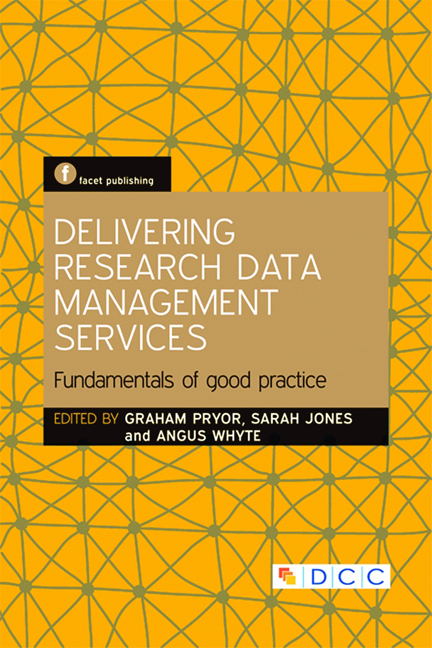Book contents
- Frontmatter
- Contents
- Preface
- Contributors
- 1 A patchwork of change
- 2 Options and approaches to RDM service provision
- 3 Who's doing data? A spectrum of roles, responsibilities and competences
- 4 A pathway to sustainable research data services: from scoping to sustainability
- 5 The range and components of RDM infrastructure and services
- 6 Case study 1: Johns Hopkins University Data Management Services
- 7 Case study 2: University of Southampton – a partnership approach to research data management
- 8 Case study 3: Monash University, a strategic approach
- 9 Case study 4: a national solution – the UK Data Service
- 10 Case study 5: development of institutional RDM services by projects in the Jisc Managing Research Data programmes
- Index
1 - A patchwork of change
Published online by Cambridge University Press: 08 June 2018
- Frontmatter
- Contents
- Preface
- Contributors
- 1 A patchwork of change
- 2 Options and approaches to RDM service provision
- 3 Who's doing data? A spectrum of roles, responsibilities and competences
- 4 A pathway to sustainable research data services: from scoping to sustainability
- 5 The range and components of RDM infrastructure and services
- 6 Case study 1: Johns Hopkins University Data Management Services
- 7 Case study 2: University of Southampton – a partnership approach to research data management
- 8 Case study 3: Monash University, a strategic approach
- 9 Case study 4: a national solution – the UK Data Service
- 10 Case study 5: development of institutional RDM services by projects in the Jisc Managing Research Data programmes
- Index
Summary
Evolution in an age of technological revolution
After a number of years in which the stock response to the accelerating data deluge was simply to throw larger and larger volumes of storage capacity to the university research community, the provision of planned and structured research data management (RDM) services has at last begun to gain a foothold across the higher education sector. So what has been going on in those most recent decades of the information age, since around 1990, and why has it taken so long for the sector to accept that it needs to introduce a new kind of support infrastructure, both technological and human?
A full nine years after Tim BernersLee launched the world wide web, an act that introduced the first truly public data search and retrieval service to the internet, the UK government's spending review of 2000 delivered its original and unprecedented escience initiative. This was designed to encourage the development of an IT infrastructure sufficient to support the increasingly global research collaborations emerging from science and engineering disciplines. Such collaborations, in fact escience itself, were characterized by the shared use of some combination of very large computing resources, enormous data collections and fast and ubiquitous access to remote facilities or sensor data. Three years later, in its Circular 6/03 (Revised) Digital Curation Centre, the UK's Joint Information Systems Committee (Jisc) called for proposals ‘to pilot the development of generic support services for maintaining digital data and research results over their entire lifecycle for current and future users’. The analysis that Jisc used to promote this initiative was that the ‘current generation of “eScience” experiments and computations will create more scientific data in the next five years than has been collected in the whole of human history. Properly curated, this data will form a major resource for future generations of scientists.’
From these beginnings, one may assume that the active curation of primary data had been recognized as a core requirement of the escience community.
- Type
- Chapter
- Information
- Delivering Research Data Management ServicesFundamentals of Good Practice, pp. 1 - 20Publisher: FacetPrint publication year: 2013
- 4
- Cited by



